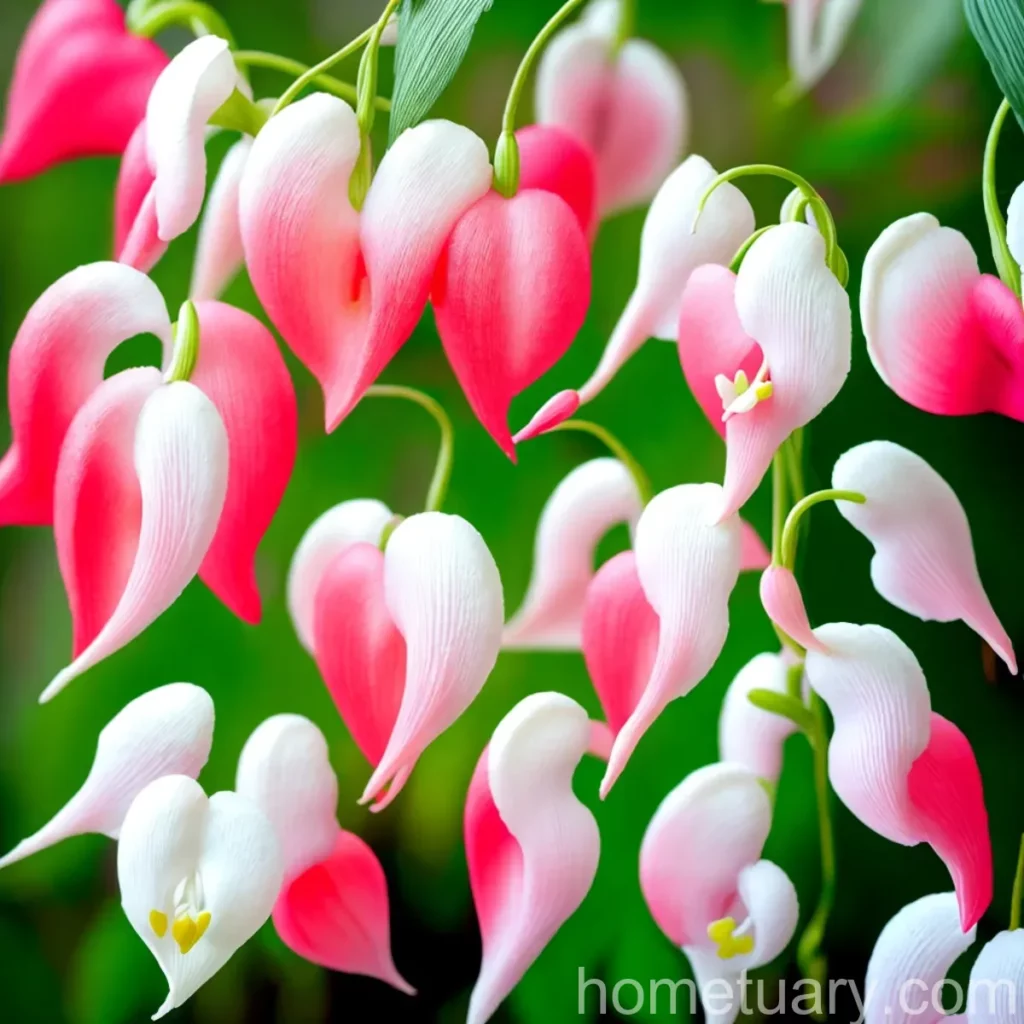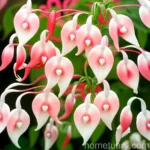The Enchanting Beauty of Bleeding Heart (Dicentra ‘Love Hearts’)
Bleeding heart, scientifically known as Dicentra ‘Love Hearts’, is a captivating and alluring perennial plant that has enchanted plant enthusiasts and horticulturists alike for centuries. This exquisite plant showcases unique heart-shaped flowers which hang gracefully from delicate arching stems, evoking a sense of romance and tranquility in any garden or landscape. In this comprehensive guide, we will delve into the mesmerizing world of bleeding heart, exploring its intriguing characteristics, cultivation, care requirements, and much more. Whether you’re a novice gardener or a seasoned horticulture aficionado, join us on a botanical journey as we unravel the enchanting allure of the bleeding heart plant.
Bleeding Heart (Dicentra ‘Love Hearts’) Overview
Plant Name: Bleeding Heart (Dicentra ‘Love Hearts’)
Bleeding Heart Plant Characteristics
Bleeding heart, scientifically classified as Dicentra ‘Love Hearts’, belongs to the Papaveraceae family. This striking perennial plant is renowned for its elegant, heart-shaped flowers which dangle gracefully from arching stems. The distinctively shaped blossoms, which resemble tiny pendants, range in color from enchanting shades of pink and white. The foliage of the bleeding heart is also noteworthy, featuring intricately cut, fern-like leaves that add to its visual appeal. The unique morphology of the bleeding heart makes it an exceptional addition to any garden or landscape, adding a touch of romance and charm.
Dicentra ‘Love Hearts’ Care Guide
Culture
The culture of bleeding heart plants primarily involves embracing their preference for cool, moist, and well-drained soil. Furthermore, these plants thrive in partial to full shade, making them an excellent choice for shaded garden beds and woodland settings. When it comes to their cultural needs, it is essential to provide them with a consistent moisture supply, especially during hot and dry periods. Adequate mulching can aid in preserving soil moisture and maintaining a stable root environment. Additionally, bleeding heart plants benefit from protection against strong winds, as their delicate stems and foliage are susceptible to damage.
Uses
Bleeding heart plants are cherished for their ornamental value and are commonly used as captivating additions to shaded borders, woodland gardens, and perennial beds. Their exquisite blooms and lacy foliage contribute to the creation of serene and enchanting landscapes. Moreover, bleeding heart flowers are often utilized in cut flower arrangements, allowing their delicate beauty to be appreciated indoors as well.
Water
Proper watering is crucial for the health and vitality of bleeding heart plants. As they prefer consistently moist soil, regular watering is essential, especially during dry spells or periods of intense heat. However, it is important to ensure that the soil is well-drained to prevent waterlogging, which can lead to root rot and other detrimental conditions.
Sunlight
Bleeding heart plants thrive in partial to full shade, making them ideal selections for areas with limited direct sunlight. While they can tolerate some morning sun, providing them with protection from intense afternoon sun is vital to prevent sunscald and stress on the delicate foliage and blooms.
Fertilizer
When it comes to fertilization, bleeding heart plants have modest needs. Applying a balanced, slow-release fertilizer in early spring can provide them with the necessary nutrients to support healthy growth and abundant flowering. It is important to follow the recommended application rates and avoid over-fertilization, which can lead to excessive foliage at the expense of flowers.
Soil
The ideal soil for bleeding heart plants is rich, well-drained, and slightly acidic. Amending the planting area with organic matter, such as compost or well-rotted manure, can enhance soil fertility and structure, creating an optimal growing environment for these delicate perennials.
Pruning
Pruning bleeding heart plants is primarily focused on removing spent flowers and any damaged or yellowing foliage. This helps to maintain a tidy appearance and can encourage a second flush of blooms in some varieties. However, it is important to avoid excessive pruning, as bleeding heart plants benefit from the presence of some foliage to support their energy production through photosynthesis.
Propagation
Propagating bleeding heart plants can be achieved through division or seed propagation. Dividing established clumps in early spring or fall allows for the creation of new plants while rejuvenating the parent specimen. Additionally, collecting and sowing ripe seeds in a suitable growing medium can yield new bleeding heart plants, although this method requires more time and patience compared to division.
Container Popularity
Bleeding heart plants are also popular choices for container gardening, particularly in shaded patios, balconies, or urban outdoor spaces. Their elegant form and alluring blooms make them captivating additions to container arrangements, adding a touch of enchantment to any outdoor setting.
Container Common Diseases
When grown in containers, bleeding heart plants may be susceptible to certain diseases and issues, including root rot caused by overwatering, as well as fungal infections favored by prolonged periods of high humidity. Proper watering practices and adequate air circulation can help mitigate these challenges and promote a healthy container-grown bleeding heart plant.
Disease Diagnosis
While bleeding heart plants are generally resilient, they can be affected by fungal diseases such as powdery mildew and leaf spot. Early diagnosis and prompt intervention through the use of appropriate fungicidal treatments can help manage these issues and prevent their spread.
Common Pests
Aphids and slugs are among the common pests that can target bleeding heart plants. Regular monitoring and the use of suitable pest control measures, such as insecticidal soap for aphids and organic slug deterrents, can assist in keeping these pests at bay and preserving the health of the plants.
Botanist’s Tips
- When selecting a planting site for bleeding heart, consider areas with filtered or dappled shade to provide the ideal growing conditions.
- Incorporate organic matter into the soil during planting to enhance fertility and improve moisture retention.
- Mulch around the base of the plants to conserve soil moisture and moderate temperature fluctuations.
- Watch for signs of pests and diseases, addressing any issues promptly to prevent them from escalating.
Fun Facts
- The captivating heart-shaped flowers of bleeding heart have earned it endearing nicknames, such as “lady-in-a-bath” and “lyre flower.”
- Bleeding heart is associated with various symbolic meanings, including love, purity, and compassion, making it a popular choice for wedding bouquets and floral arrangements with heartfelt sentiments.
Links to External Resources
For further information about bleeding heart plants and their cultivation, you may find the following resources valuable:
1. The Royal Horticultural Society (RHS) – Dicentra spectabilis
2. University of California Agriculture and Natural Resources – Dicentra Species
In conclusion, the mesmerizing allure of bleeding heart plants, exemplified by Dicentra ‘Love Hearts’, makes them captivating additions to any garden or landscape. From their elegant heart-shaped blooms to their graceful foliage, these plants evoke a sense of enchantment and romance, enriching outdoor spaces with their timeless charm. Understanding and embracing their unique cultural requirements and care guidelines paves the way for a flourishing and captivating display of bleeding heart plants in the garden. Whether admired for their ornamental value, symbolic significance, or medicinal folklore, bleeding heart plants continue to captivate and fascinate plant enthusiasts, showcasing the enduring allure of nature’s botanical treasures.















